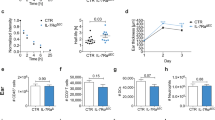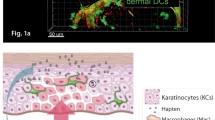Abstract
GM-CSF together with IL-1β and TNF-α has been shown to play a key role in the maturation of LC in vitro. To investigate the presence of GM-CSF, IL-1β and TNF-α in human skin-derived lymph, we cannulated microsurgically a superficial lymph vessel on the lower leg of six healthy volunteers. Messenger RNA levels were estimated by a reverse transcriptase polymerase chain reaction (RT-PCR) method. From a total of 20 different samples, each consisting of 106 lymph cells, total RNA was extracted, reverse transcribed to cDNA and amplified using specific primers for the target gene. Amplified products were sized by electrophoresis and visualized by ethidium bromide. Specific transcripts for GM-CSF were detected in all lymph samples, indicating that circulating human skin-derived lymph cells express GM-CSF mRNA. A mean level of 11.5±2.1 pg/ml GM-CSF was detected in the lymph samples examined, as determined by a sensitive ELISA. In contrast to GM-CSF, occasional weak mRNA signals together with a mean level of 2.7±2.2 pg/ml were found for IL-1β, and neither specific transcripts nor protein were detected for TNF-α. Thus, our results demonstrate that afferent skin lymph cells constitutively express GM-CSF.
Similar content being viewed by others
Abbreviations
- DC :
-
dendritic cells
- ELISA :
-
enzyme-linked immunosorbent assay
- GM-CSF :
-
granulocyte/macrophage colony-stimulating factor
- IL-1β:
-
interleukin-1β
- LC :
-
Langerhans cells
- LPS :
-
lipopolysaccharides
- PBMC :
-
peripheral blood mononuclear cells
- RT-PCR :
-
reverse transcriptase-polymerase chain reaction
- TNF-α:
-
tumour necrosis factor α
References
Gasson J (1991) Molecular physiology of granulocyte-macrophage colony-stimulating factor. Blood 77:1131–1145.
Pimental E (1994) Handbook of growth factors, vol III. CRC Press, Boca Raton, pp 177–220
Rasko EJ, Gough NM (1994) Granulocyte-macrophage colonystimulating factor. In: Thomson A (ed) The cytokine handbook. 2nd edn. Academic Press, New York, pp 343–369
Witmer-Pack MD, Olivier W, Valinsky J, Schuler G, Steinman RM (1987) Granulocyte/macrophage colony-stimulating factor is essential for the viability and function of cultured murine epidermal Langerhans cells. J Exp Med 166:1484–1498
Inaba K, Schuler G, Steinman RM (1993) GM-CSF—a granulocyte/macrophage/dendritic cell stimulating factor. In: Furth R van (ed) Hemopoietic growth factors and mononuclear phagocytes Karger, Basel, pp 187–196
Schuler G, Steinman RM (1985) Murine epidermal Langerhans cells mature into potent immunostimulatory dendritic cells in vitro. J Exp Med 161:526–546
Chang CH, Furue M, Tamaki K (1994) Selective regulation of ICAM-1 and major histocompatibility complex class I and II molecule expression on epidermal Langerhans cells by some of the cytokines released by keratinocytes and T cells. Eur J Immunol 24:2889–2895
Larsen CP, Ritchie SC, Hendrix R, Linsley PS, Hathcock KS, Hodes RJ, Lowry RP, Rearson TC (1994) Regulation of immunostimulatory function and costimulatory molecule (B7-1 and B7-2) expression on murine dendritic cells. J Immunol 152:5208–5219
Heufler C, Koch F, Schuler G (1988) Granulocyte/macrophage colony-stimulating factor and Interleukin-1 mediate the maturation of murine epidermal Langerhans cells into potent immunostimulatory dendritic cells. J Exp Med 167:700–705
Koch F, Heufler C, Kämpgen E, Schneeweiss D, Böck G, Schuler G (1990) TNF-α maintains viability of murine epidermal Langerhans cells in culture, but in contrast to granulocyte/macrophage colony-stimulating factor, without inducing their functional maturation. J Exp Med 171:159–171
Romani N, Lenz A, Glassel H, Stössel H, Stanzl U, Majdic O, Fritsch P, Schuler G (1989) Cultured human Langerhans cells resemble lymphoid DC in phenotype and function. J Invest Dermatol 93:600–609
Brand CU, Gerber H, Hunziker T, Schaffner T, Limat A, Braathen LR (1993) Phenotype of Langerhans cells in human afferent skin lymph derived from allergic contact dermatitis. Exp Dermatol 2:274–279
Brand CU, Hunziker T, Braathen LR (1992) Isolation of human skin derived lymph. Arch Dermatol Res 284:123–126
Chomczynsky P, Sachi N (1987) Single-step method of RNA isolation by acid guanidinium thiocyanate-phenol-chloroform extraction. Anal Biochem 162:156–159
Romani N, Heufler C, Koch F, Topar G, Kämpgen E, Schuler G (1994) Cytokines and Langerhans cells. In: Luger TA, Schwarz T (eds) Epidermal growth factors and cytokines. Marcel Dekker, New York Basel, pp 345–363
Inaba K, Metlay JP, Crowley MT, Witmer-Pack M, Steinman RM (1990) Dendritic cells as antigen presenting cells in vivo. Int Rev Immunol 6:197–206
O’Doherty U, Steinmann RM, Peng M, Cameron PU, Gezelter S, Kopeloff I, Swiggard WJ, Pope M, Bhardwaj N (1993) Dendritic cells freshly isolated from human blood express CD4 and mature into typical immunostimulatory dendritic cells after culture in monocyte-conditioned medium. J Exp Med 178: 1067–1078
Teunissen MBM (1992) Dynamic nature and function of epidermal Langerhans cells in vivo and intro: a review, with emphasis on human Langerhans cells. Histochem J 24:697–716
Stingl G, Tamaki K, Katz SI (1980) Origin and function of epidermal Langerhans cells. Immunol Rev 53:149–174
Brand CU, Hunziker T, Schaffner T, Limat A, Gerber H, Braathen LR (1995) Activated immunocompetent cells in human skin lymph derived from irritant contact dermatitis: an immunomorphological study. Br J Dermatol 132:39–45
Silberberg-Sinakin I, Thorbecke GJ, Baer RL, Rosenthal SA, Berezowsky V (1976) Antigen-bearing Langerhans cells in skin, dermal lymphatics and in lymph nodes. Cell Immunol 25:137–151
Kripke ML, Munn CG, Jeevan A, Tang JM, Bucana C (1990) Evidence that cutaneous antigen presenting cells migrate to regional lymph nodes during contact sensitization. J Immunol 145:2833–2838
Gerberick GF, Ryan CA, Fletcher ER, Howard AD, Robinson MK (1991) Increased number of dendritic cells in draining lymph nodes accompanies the generation of contact photosensitivity. J Invest Dermatol 96:355–361
Inaba K, Schuler G, Witmer MD, Valinski J, Atassi B, Steinman RM (1986) Immunologic properties of purified epidermal Langerhans cells. Distinct requirements for stimulation of unprimed and sensitized T lymphocytes. J Exp Med 164:605–613
Inaba K, Steinmann RM (1986) Accessory cell-T lymphocyte interactions. Antigen-dependent and-independent clustering. J Exp Med 163:247–261
Inaba K, Romani N, Steinman RM (1989) An antigen-independent contact mechanism as an early step in T cell-proliferative responses to dendritic cells. J Exp Med 170:527–542
Romani N, Schuler G (1992) The immunologic properties of epidermal Langerhans cells as a part of the dendritic cell system. Springer Semin Immunopathol 13:265–279
Kasinrerk W, Baumruker T, Majdic O, Knapp W, Stockinger H (1993) CD 1 molecule expression on human monocytes induced by granulocyte-macrophage colony-stimulating factor. J Immunol 150:579–584
Larsen CP, Steinman RM, Witmer-Pack M, Hankins DF, Morris PJ, Austyn JM (1990) Migration and maturation of Langerhans cells in skin transplants and explants. J Exp Med 172: 1483–1493
MacPherson GG, Fossum S, Harrison B (1989) Properties of lymph-borne (veiled) dendritic cells in culture. II. Expression of the IL-2 receptor: role of GM-CSF. Immunology 68:108–113
Brand CU, Hunziker T, Limat A, Braathen LR (1993) Large increase of Langerhans cells in human skin lymph derived from irritant contact dermatitis. Br J Dermatol 128:184–188
Hunziker T, Brand CU, Kapp A, Wälti ER, Braathen LR (1992) Increased levels of inflammatory cytokines in human skin lymph derived from irritant contact dermatitis. Br J Dermatol 127:254–257
Koike K, Ogawa M, Ihle JN, Miyake T, Shimizu T, Miyajima A, Yokota T, Arai K (1987) Recombinant murine granulocytemacrophage colony-stimulating factor supports formation of GM and multipotential blast cell colonies in culture: comparison with the effects of interleukin-3. J Cell Physiol 131:458–464
Author information
Authors and Affiliations
Additional information
These investigations were supported by a grant from the Swiss National Fund (32-38813.93)
Rights and permissions
About this article
Cite this article
Yawalkar, N., Brand, C.O. & Braathen, L.R. GM-CSF mRNA and protein in human skin-derived lymph. Arch Dermatol Res 288, 637–640 (1996). https://doi.org/10.1007/BF02505271
Received:
Issue Date:
DOI: https://doi.org/10.1007/BF02505271




